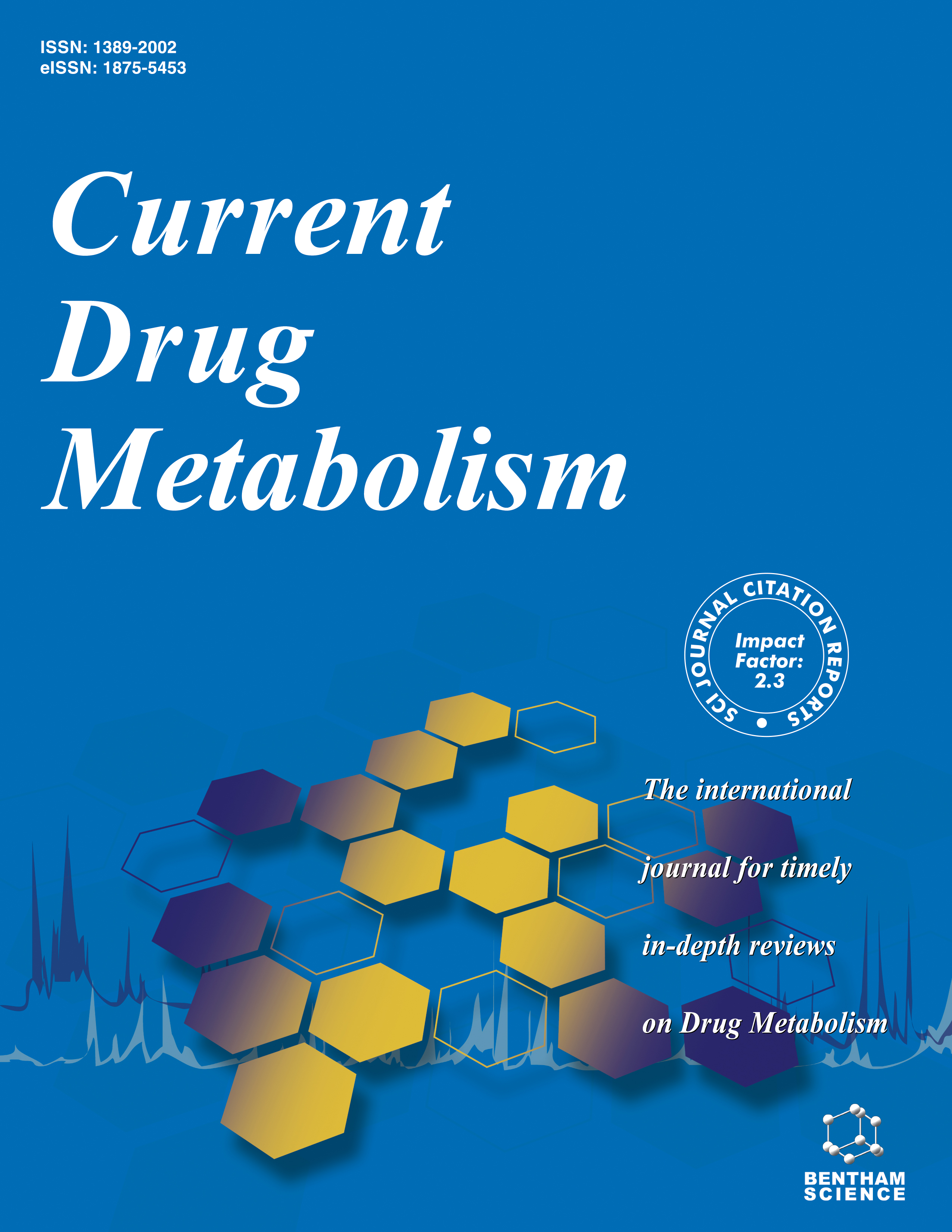- Home
- A-Z Publications
- Current Drug Metabolism
- Previous Issues
- Volume 11, Issue 4, 2010
Current Drug Metabolism - Volume 11, Issue 4, 2010
Volume 11, Issue 4, 2010
-
-
Editorial [Hot topic: Network Topological Indices, Drug Metabolism, and Distribution (Guest Editor: H. Gonzalez-Diaz)]
More LessMany authors have been used Graph and Complex Network theory to approach very large metabolic networks with low computational cost. These large networks are graphical representations of real metabolic systems with essentially two components nodes and links. Nodes (represented by dots) are usually metabolites, enzymes, substrates, intermediary substances, metabolic reactions or transition states. Node-to-node link Read More
-
-
-
Predictions of the ADMET Properties of Candidate Drug Molecules Utilizing Different QSAR/QSPR Modelling Approaches
More LessThe integration of early ADMET (absorption, distribution, metabolism, excretion and toxicity) profiling, or simply prediction, of 'lead' molecules to speed-up the 'lead' selection further for phase-I trial without losing large amount of revenue. The ADMET profiling and prediction is mostly dependent of a number of molecular descriptors, for example, Lipinski's 'Rule of 5' (Ro5). Recently a large number of articles have been Read More
-
-
-
Gender Specific Drug Metabolism of PF-02341066 in Rats — Role of Sulfoconjugation
More LessAuthors: Wei-Zhu Zhong, Jenny Zhan, Ping Kang and Shinji YamazakiPF-02341066 is a selective c-Met/Alk tyrosine kinase inhibitor currently in clinical development as an anticancer agent. Non-clinical toxicokinetic evaluation in rats revealed gender-related differences in pharmacokinetics with at least 2-fold higher PF-02341066 plasma concentrations in males than females when administered the same dose. In general, lower systemic exposure of drugs that undergoes oxidative metabolism in Read More
-
-
-
QSAR & Complex Network Study of the HMGR Inhibitors Structural Diversity
More LessAuthors: Isela Garcia, Yagamare Fall and Generosa GomezEfficient drugs such as statins or mevinic acids are inhibitors of the rate-limiting enzyme of cholesterol biosynthesis, 3- hydroxy-3-methyl-glutaryl coenzyme A reductase (HMGR), an enzyme responsible for the double reduction of 3-hydroxy-3-methyl-glutaryl coenzyme A. These compounds promoted the synthesis and evaluation of new inhibitors for HMGR, named HMGRIs. The high number of possible candidates creates the Read More
-
-
-
Mathematical Methods to Analysis of Topology, Functional Variability and Evolution of Metabolic Systems Based on Different Decomposition Concepts
More LessAuthors: Yassine Mrabet and Nabil SemmarComplexity of metabolic systems can be undertaken at different scales (metabolites, metabolic pathways, metabolic network map, biological population) and under different aspects (structural, functional, evolutive). To analyse such a complexity, metabolic systems need to be decomposed into different components according to different concepts. Four concepts are presented here consisting in considering metabolic system Read More
-
-
-
Molecular Modeling of Cytochrome P450 and Drug Metabolism
More LessAuthors: Jing-Fang Wang and Kuo-Chen ChouThe cytochrome P450 family is a large and diverse group of hemoproteins that are located in virtually all types of organism, such as bacteria, eukaryotes and even Archaea. These proteins are found throughout the body, however the highest concentrations are associated with liver. As the Human Genome Project completed, there are 57 genes and more than 59 pseudogenes divided among 18 families of CYP genes and 43 Read More
-
-
-
Artificial Intelligence Techniques for Colorectal Cancer Drug Metabolism: Ontologies and Complex Networks
More LessAuthors: Marcos Martinez-Romero, Jose M. Vazquez-Naya, Juan R. Rabunal, Salvador Pita-Fernandez, Ramiro Macenlle, Javier Castro-Alvarino, Leopoldo Lopez-Roses, Jose L. Ulla, Antonio V. Martinez-Calvo, Santiago Vazquez, Javier Pereira, Ana B. Porto-Pazos, Julian Dorado, Alejandro Pazos and Cristian R. MunteanuColorectal cancer is one of the most frequent types of cancer in the world and generates important social impact. The understanding of the specific metabolism of this disease and the transformations of the specific drugs will allow finding effective prevention, diagnosis and treatment of the colorectal cancer. All the terms that describe the drug metabolism contribute to the construction of ontology in order to help scientists t Read More
-
-
-
Graphic Rule for Drug Metabolism Systems
More LessUsing graphic rules to deal with kinetic systems is an elegant approach by combining the graph representation (schematic representation) and rigorous mathematical derivation. It bears the following advantages: (1) providing an intuitive picture or illuminative insights; (2) helping grasp the key points from complicated details; (3) greatly simplifying many tedious, laborious, and error-prone calculations; and (4) able to double- Read More
-
-
-
Review of MARCH-INSIDE & Complex Networks Prediction of Drugs: ADMET, Anti-parasite Activity, Metabolizing Enzymes and Cardiotoxicity Proteome Biomarkers
More LessIn this communication we carry out an in-depth review of a very versatile QSPR-like method. The method name is MARCH-INSIDE (MARkov CHains Ivariants for Network Selection and DEsign) and is a simple but efficient computational approach to the study of QSPR-like problems in biomedical sciences. The method uses the theory of Markov Chains to generate parameters that numerically describe the structure of a system. Thi Read More
-
Volumes & issues
-
Volume 25 (2024)
-
Volume 24 (2023)
-
Volume 23 (2022)
-
Volume 22 (2021)
-
Volume 21 (2020)
-
Volume 20 (2019)
-
Volume 19 (2018)
-
Volume 18 (2017)
-
Volume 17 (2016)
-
Volume 16 (2015)
-
Volume 15 (2014)
-
Volume 14 (2013)
-
Volume 13 (2012)
-
Volume 12 (2011)
-
Volume 11 (2010)
-
Volume 10 (2009)
-
Volume 9 (2008)
-
Volume 8 (2007)
-
Volume 7 (2006)
-
Volume 6 (2005)
-
Volume 5 (2004)
-
Volume 4 (2003)
-
Volume 3 (2002)
-
Volume 2 (2001)
-
Volume 1 (2000)
Most Read This Month
Article
content/journals/cdm
Journal
10
5
false
en


